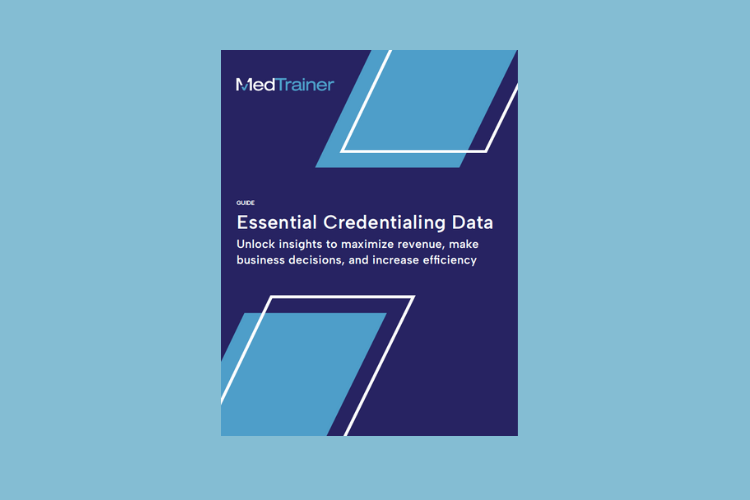For many healthcare executives, credentialing can seem like a black hole. In fact, during a recent webinar I hosted, only 8% of poll respondents said executives had enough visibility into their organization’s credentialing process. So, if you feel like you’re in the dark, you’re not alone.
It’s hard to provide visibility into such a complex process, which is often siloed, and largely outside your organization’s control. Leveraging credentialing data offers the insight you need to plan better, mitigate risks, and keep revenue flowing. In this article, I’ll share 10 data points that I think every executive should have, why the information is so valuable, and the easiest way to get it (spoiler alert: you need healthcare credentialing software).
Credentialing Data Every Executive Needs
These high-level metrics offer healthcare executives a comprehensive view of their credentialing operations, enabling them to make informed decisions about resource allocation and process optimization.
Number of closed enrollment applications by month
This metric helps executives better plan resources. To accommodate a higher volume, temporary help may be needed, or the process may take longer. For example, credentialing is slowest in the winter months, which means up to 30 extra days may be needed to complete enrollments. Summer months are busier due to medical school graduations, and temporary staff may be needed to help your credentialing team.
Unsubmitted applications by age (two weeks or longer)
Seeing enrollment applications just sitting often indicates a chance of lost revenue and staffing issues. When a provider’s start date is pushed back, fewer patients are seen which can mean scheduling complications. Stalled enrollment applications can also be a signal of credentialing issues.
Unsubmitted application total
This number allows you to see at a glance whether unsubmitted applications are higher or lower than normal, allowing you to adjust staffing strategies or improve processes.
Open enrollment applications by status
Understanding the stage where applications stall at a higher rate can help you improve processes or allocate additional resources. It can also help you gauge when providers will be ready to see patients, which helps you project cash flow and manage financial planning.
Open enrollment applications by age
Applications older than 30 may be at risk of expiration, meaning the entire process would need to be restarted—a 30-day delay. This would impact the provider’s ability to be reimbursed and directly impact the organization’s revenue flow.
Average response time by payer
There are myriad reasons provider enrollment applications can be delayed. When you know which payer is taking the longest, you can decide if it is worth enrolling with them. You can also reach out to ask questions and advocate for your organization.
Closed applications by credentialer
Understanding which credentialers close applications the fastest or at the highest volume will enable you to replicate their success across the team. For example, maybe they’re using a really great enrollment checklist that can speed up other credentials on staff. Of course, this data can also help you identify credentials who face challenges.
Most common claim denial codes
Knowing your organization’s most common credentialing-related denial codes gives you insight into an internal process or payer issue. If it’s a payer issue, you can have more targeted discussions on resolving specific problems and improving the claims process.
Number of providers by specialty and location
Tracking this data helps identify gaps in coverage, allowing executives to make informed decisions about where to recruit additional providers or expand services. You can also ensure you meet the plan’s requirements to remain in the network.
Number of providers enrolled with each payer
This data shows if individual payers receive your providers’ claims but are not reimbursed. You can then investigate the reasons behind the lack of reimbursement by the payer and address common issues such as errors in claim submission, issues with payer contracts, or discrepancies in provider information.

Get the credentialing data you can't live without.
Get the Data You Need With Credentialing Software
Comprehensive credentialing software is the best—and maybe the only—way to get the data you need in one place, at speed. Pulling information from multiple technology systems and compiling spreadsheets is time-consuming and error-prone.
Here’s how credentialing software provides the data you need:
- Data centralization and accessibility: All credentialing data and actions are completed in one secure, easily accessible system. This allows for customizable reports and a comprehensive view across the entire organization.
- Highly customizable reporting: Every level of the organization needs different information to handle staffing and maintain revenue. Customized reports make it possible for everyone to get what they need—executives can monitor revenue-dependent metrics, while each department or location can get updates on their providers.
- Data visualization: Customizable dashboards offer at-a-glance key metrics like time-to-credential, payer turnaround times, and application volume. This enables data-driven decision-making and performance tracking.
- Automation: The ability to save, schedule, and send reports is a game changer for large organizations. Set reports to be sent internally or externally on a pre-set cadence automatically.
Leveraging credentialing software gives healthcare professionals the data they need to make critical business decisions and keep revenue intact.
See why thousands of healthcare organizations choose MedTrainer.
